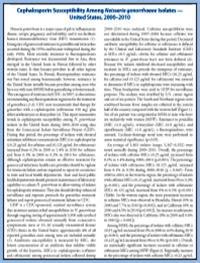This report summarizes trends in cephalosporin susceptibility among N. gonorrhoeae isolates in the United States during 2000--2010 using data from the Gonococcal Isolate Surveillance Project (GISP). During that period, the percentage of isolates with elevated minimum inhibitory concentrations (MICs) to cephalosporins (=0.25 µg/mL for cefixime and =0.125 µg/mL for ceftriaxone) increased from 0.2% in 2000 to 1.4% in 2010 for cefixime and from 0.1% in 2000 to 0.3% in 2010 for ceftriaxone. Although cephalosporins remain an effective treatment for gonococcal infections, health-care providers are advised to be vigilant for treatment failure and are requested to report its occurrence to state and local health departments. State and local public health departments should promote maintenance of laboratory capability to culture N. gonorrhoeae to allow testing of isolates for cephalosporin resistance. They also should develop enhanced surveillance and response protocols for gonorrhea treatment failures and report gonococcal treatment failures to CDC.
Format:
Report
Publication Date:
2011
ID:
35206
- STI
- Gonorrhea
- MDR TB


